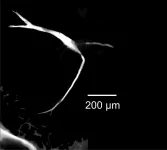(Press-News.org) Smoking cannabis when you're young may increase your risk of developing heart disease later, according to a recent University of Guelph study.
In the first study to look at specific risk indicators for cardiovascular disease (CVD) in young, healthy cannabis users, researchers found subtle but potentially important changes in heart and artery function.
Cigarette smoking is known to affect cardiovascular health, causing changes to blood vessels and the heart. Less is known about the impact of smoking cannabis on long-term CVD risk, even as use of the substance grows in Canada and abroad. Cannabis is the most commonly used recreational substance worldwide after alcohol.
"Cannabis is really widely used as a recreational substance all around the world and is becoming increasingly so," said Christian Cheung, a PhD student in the Human Performance and Health Research Lab, part of the Department of Human Health and Nutritional Sciences (HHNS). "Scientists haven't done that research with cannabis."
Cheung is the lead author of the study, published recently in the Journal of Applied Physiology. His co-authors were Dr. Jamie Burr and Dr. Philip Millar, both professors in HHNS and PhD student Alexandra Coates.
The team studied 35 subjects aged 19 to 30, half of whom were cannabis users. For all subjects, they used ultrasound imaging to look at the heart and arteries. They measured arterial stiffness and arterial function, or the ability of arteries to appropriately expand with greater blood flow. All three measures are indicators of cardiovascular function and potential disease risk.
Arterial stiffness was greater in cannabis users than in non-users. The team measured how fast a pressure wave travelled down the artery; stiffer arteries transmit a wave more quickly.
In cannabis users, cardiac function - inferred from how the heart moves as seen in echocardiographic images -- was lower than in non-users.
Cheung said the team was surprised to see no difference in artery dilation in response to changing blood flow.
All three measures normally change in cigarette smokers, with stiffer arteries and lower vascular and heart function.
"We don't yet know why in cannabis users there's no difference in vascular function," he said.
Cheung said differences may reflect variations in how tobacco and cannabis are consumed, as well as amounts and frequency and the user's age.
"We looked at young cannabis users. In the cigarette literature, heavy, long-term smokers show reduced vascular function but that's not necessarily the case for younger smokers."
The U of G researchers plan further studies to learn about potential impacts of these changes and disease risk in people who use cannabis.
"This is exciting new data, suggesting that even before more overt signs and symptoms of cardiovascular disease are present, there may be more subtle indications in altered physiological function," said Burr.
"It also paves the way to our next studies, aimed at understanding the direct effects of cannabis consumption, and how this may interact with common stressors of everyday life, like exercise."
Cheung emphasized that few studies have been done on the impacts of cannabis use on cardiovascular health.
"This is an exciting field of research given the ubiquity of cannabis use and the knowledge gap that exists, it's a field ripe with opportunity."
INFORMATION:
High blood pressure, the most important cause of disease worldwide, accelerates atherosclerosis but the mechanism is unknown. Using gene modified minipigs, researchers from the Centro Nacional de Investigaciones Cardiovasculares (CNIC) and Aarhus University (Denmark), demonstrate that high blood pressure alters the structure of arteries leading to more accumulation of LDL cholesterol and faster development of atherosclerosis. The study has been published in The Journal of the American College of Cardiology (JACC).
Blood pressure-lowering drugs are routinely used to prevent the development of atherosclerosis and heart disease, but the mechanism of this effect is still ...
The detrimental impact of pesticides on non-target organisms is one of the most urgent concerns in current agriculture. Double-stranded RNAs (dsRNAs) represent the most species-specific class of pesticides to date, potentially allowing control of a target pest without effecting other species. The unprecedented target-specificity of dsRNA is due to its nucleotide sequence-specific mode of action that results in post-transcriptional gene silencing, or RNA interference (RNAi), in the target species. The development and field use of dsRNAs, via both the insertion of transgenes into the plant genome and the application ...
The plasticisers contained in many everyday objects can impair important brain functions in humans. Biologists from the University of Bayreuth warn of this danger in an article in Communications Biology. Their study shows that even small amounts of the plasticisers bisphenol A and bisphenol S disrupt the transmission of signals between nerve cells in the brains of fish. The researchers consider it very likely that similar interference can also occur in the brains of adult humans. They therefore call for the rapid development of alternative plasticisers that do ...
MINNEAPOLIS/ST.PAUL (04/12/2021) -- A new probe into the lingering impacts of the COVID-19 pandemic revealed correlations to six unhealthy eating behaviors, according to a study by the University of Minnesota Medical School and School of Public Health. Researchers say the most concerning finding indicates a slight increase or the re-emergence of eating disorders, which kill roughly 10,200 people every year -- about one person every 52 minutes.
U of M Medical School's Melissa Simone, PhD, a postdoctoral research fellow in the Department of Psychiatry and Behavioral Sciences, collaborated with School of Public Health ...
BOSTON - (April 12, 2021) - A new source of energy expending brown fat cells has been uncovered by researchers at the Joslin Diabetes Center, which they say points towards potential new therapeutic options for obesity. According to the new report, published today by Nature Metabolism, the key lies in the expression of a receptor called Trpv1 (temperature-sensitive ion channel transient receptor potential cation subfamily V member 1) -- a protein known to sense noxious stimuli, including pain and temperature.
Specifically, the authors point to smooth muscle cells expressing the Trpv1 receptor and identify them as a novel source of energy-burning brown fat cells (adipocytes). This should translate into increased overall energy ...
Histones are tiny proteins that bind to DNA and hold information that can help turn on or off individual genes. Researchers at Karolinska Institutet have developed a technique that makes it possible to examine how different versions of histones bind to the genome in tens of thousands of individual cells at the same time. The technique was applied to the mouse brain and can be used to study epigenetics at a single-cell level in other complex tissues. The study is published in the journal Nature Biotechnology.
"This technique will be an important tool for examining what makes cells different from each other at the epigenetic level," says Marek ...
WASHINGTON--Deep in a Jamaican cave is a treasure trove of bat poop, deposited in sequential layers by generations of bats over 4,300 years.
Analogous to records of the past found in layers of lake mud and Antarctic ice, the guano pile is roughly the height of a tall man (2 meters), largely undisturbed, and holds information about changes in climate and how the bats' food sources shifted over the millennia, according to a new study.
"We study natural archives and reconstruct natural histories, mostly from lake sediments. This is the first time scientists have interpreted past bat ...
BOSTON - Exercise training may slow tumor growth and improve outcomes for females with breast cancer - especially those treated with immunotherapy drugs - by stimulating naturally occurring immune mechanisms, researchers at Massachusetts General Hospital (MGH) and Harvard Medical School (HMS) have found.
Tumors in mouse models of human breast cancer grew more slowly in mice put through their paces in a structured aerobic exercise program than in sedentary mice, and the tumors in exercised mice exhibited an increased anti-tumor immune response.
"The most exciting finding was that exercise training brought into tumors immune cells capable of killing cancer cells known as cytotoxic T lymphocytes (CD8+ ...
Philadelphia, April 12, 2021 - Electronic cigarette (EC) use, or vaping, has both gained incredible popularity and generated tremendous controversy, but although they may be less harmful than tobacco cigarettes (TCs), they have major potential risks that may be underestimated by health authorities, the public, and medical professionals. Two cardiovascular specialists review the latest scientific studies on the cardiovascular effects of cigarette smoking versus ECs in the Canadian Journal of Cardiology, published by Elsevier. They conclude that young non-smokers should be discouraged from vaping, flavors targeted towards adolescents should be banned, and laws and regulations ...
What exactly happens when the corona virus SARS-CoV-2 infects a cell? In an article published in Nature, a team from the Technical University of Munich (TUM) and the Max Planck Institute of Biochemistry paints a comprehensive picture of the viral infection process. For the first time, the interaction between the coronavirus and a cell is documented at five distinct proteomics levels during viral infection. This knowledge will help to gain a better understanding of the virus and find potential starting points for therapies.
When a virus enters a cell, viral and cellular protein molecules begin to interact. Both the replication of the virus and the reaction of ...





